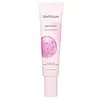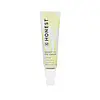What's inside
What's inside
 Key Ingredients
Key Ingredients

 Benefits
Benefits

 Concerns
Concerns

 Ingredients Side-by-side
Ingredients Side-by-side

Water
Skin ConditioningCaprylic/Capric Triglyceride
MaskingButyrospermum Parkii Butter
Skin ConditioningNiacinamide
SmoothingPalmitoyl Tripeptide-5
Skin ConditioningPanthenol
Skin ConditioningSodium Hyaluronate
HumectantGlyceryl Stearate
EmollientGlycerin
HumectantHydroxypropyl Cyclodextrin
MaskingPalmitoyl Tripeptide-38
Skin ConditioningPolyglyceryl-2 Stearate
EmulsifyingStearyl Alcohol
EmollientGlycine Soja Protein
EmulsifyingHydrolyzed Rice Protein
Skin ConditioningSuperoxide Dismutase
AntioxidantAscorbic Acid
AntioxidantSqualane
EmollientCaffeine
Skin ConditioningHesperidin
EmollientGlycyrrhiza Glabra Root Extract
BleachingIsopropyl Palmitate
EmollientArgania Spinosa Kernel Oil
EmollientOpuntia Ficus-Indica Stem Extract
Skin ConditioningMicrocrystalline Cellulose
AbsorbentCellulose Gum
Emulsion StabilisingTocopherol
AntioxidantChamomilla Recutita Flower Extract
MaskingPhenethyl Alcohol
MaskingCaprylyl Glycol
EmollientEthylhexylglycerin
Skin ConditioningPunica Granatum Seed Oil
EmollientXanthan Gum
EmulsifyingCamellia Sinensis Extract
AntioxidantCitrus Aurantifolia Peel Extract
CleansingCeramide NP
Skin ConditioningWater, Caprylic/Capric Triglyceride, Butyrospermum Parkii Butter, Niacinamide, Palmitoyl Tripeptide-5, Panthenol, Sodium Hyaluronate, Glyceryl Stearate, Glycerin, Hydroxypropyl Cyclodextrin, Palmitoyl Tripeptide-38, Polyglyceryl-2 Stearate, Stearyl Alcohol, Glycine Soja Protein, Hydrolyzed Rice Protein, Superoxide Dismutase, Ascorbic Acid, Squalane, Caffeine, Hesperidin, Glycyrrhiza Glabra Root Extract, Isopropyl Palmitate, Argania Spinosa Kernel Oil, Opuntia Ficus-Indica Stem Extract, Microcrystalline Cellulose, Cellulose Gum, Tocopherol, Chamomilla Recutita Flower Extract, Phenethyl Alcohol, Caprylyl Glycol, Ethylhexylglycerin, Punica Granatum Seed Oil, Xanthan Gum, Camellia Sinensis Extract, Citrus Aurantifolia Peel Extract, Ceramide NP
Water
Skin ConditioningGlycerin
HumectantGlyceryl Stearate Se
EmulsifyingCetearyl Alcohol
EmollientCoco-Caprylate/Caprate
EmollientPropanediol
SolventCetyl Alcohol
EmollientDimethicone
EmollientHelianthus Annuus Seed Oil
EmollientBellis Perennis Flower Extract
Skin ConditioningCoconut Alkanes
EmollientSilica
AbrasiveGlyceryl Stearate Citrate
EmollientSaccharomyces Ferment Filtrate
HumectantHieracium Pilosella Extract
MaskingTetrahexyldecyl Ascorbate
AntioxidantTrisodium Ethylenediamine Disuccinate
1,2-Hexanediol
Skin ConditioningHydroxyacetophenone
AntioxidantSodium Acetylated Hyaluronate
HumectantSodium Hyaluronate
HumectantSclerotium Gum
Emulsion StabilisingXanthan Gum
EmulsifyingButyrospermum Parkii Butter
Skin ConditioningCitric Acid
BufferingTocopherol
AntioxidantSodium Citrate
BufferingCaprylyl Glycol
EmollientSodium Benzoate
MaskingSodium Dehydroacetate
PreservativeCI 77891
Cosmetic ColorantCI 77491
Cosmetic ColorantWater, Glycerin, Glyceryl Stearate Se, Cetearyl Alcohol, Coco-Caprylate/Caprate, Propanediol, Cetyl Alcohol, Dimethicone, Helianthus Annuus Seed Oil, Bellis Perennis Flower Extract, Coconut Alkanes, Silica, Glyceryl Stearate Citrate, Saccharomyces Ferment Filtrate, Hieracium Pilosella Extract, Tetrahexyldecyl Ascorbate, Trisodium Ethylenediamine Disuccinate, 1,2-Hexanediol, Hydroxyacetophenone, Sodium Acetylated Hyaluronate, Sodium Hyaluronate, Sclerotium Gum, Xanthan Gum, Butyrospermum Parkii Butter, Citric Acid, Tocopherol, Sodium Citrate, Caprylyl Glycol, Sodium Benzoate, Sodium Dehydroacetate, CI 77891, CI 77491
Ingredients Explained
These ingredients are found in both products.
Ingredients higher up in an ingredient list are typically present in a larger amount.
This ingredient is also known as shea butter. It is an effective skin hydrator and emollient.
Emollients help soothe and soften your skin. It does this by creating a protective film on your skin. This barrier helps trap moisture and keeps your skin hydrated. Emollients may be effective at treating dry or itchy skin.
Shea butter is rich in antioxidants. Antioxidants help fight free-radicals, or molecules that may harm the body. It is also full of fatty acids including stearic acid and linoleic acid. These acids help replenish the skin and keep skin moisturized.
While Shea Butter has an SPF rating of about 3-4, it is not a sunscreen replacement.
Shea butter may not be fungal acne safe. We recommend speaking with a professional if you have any concerns.
Learn more about Butyrospermum Parkii ButterCaprylyl Glycol is a humectant and emollient, meaning it attracts and preserves moisture.
It is a common ingredient in many products, especially those designed to hydrate skin. The primary benefits are retaining moisture, skin softening, and promoting a healthy skin barrier.
Though Caprylyl Glycol is an alcohol derived from fatty acids, it is not the kind that can dry out skin.
This ingredient is also used as a preservative to extend the life of products. It has slight antimicrobial properties.
Learn more about Caprylyl GlycolGlycerin is already naturally found in your skin. It helps moisturize and protect your skin.
A study from 2016 found glycerin to be more effective as a humectant than AHAs and hyaluronic acid.
As a humectant, it helps the skin stay hydrated by pulling moisture to your skin. The low molecular weight of glycerin allows it to pull moisture into the deeper layers of your skin.
Hydrated skin improves your skin barrier; Your skin barrier helps protect against irritants and bacteria.
Glycerin has also been found to have antimicrobial and antiviral properties. Due to these properties, glycerin is often used in wound and burn treatments.
In cosmetics, glycerin is usually derived from plants such as soybean or palm. However, it can also be sourced from animals, such as tallow or animal fat.
This ingredient is organic, colorless, odorless, and non-toxic.
Glycerin is the name for this ingredient in American English. British English uses Glycerol/Glycerine.
Learn more about GlycerinSodium Hyaluronate is hyaluronic acid's salt form. It is commonly derived from the sodium salt of hyaluronic acid.
Like hyaluronic acid, it is great at holding water and acts as a humectant. This makes it a great skin hydrating ingredient.
Sodium Hyaluronate is naturally occurring in our bodies and is mostly found in eye fluid and joints.
These are some other common types of Hyaluronic Acid:
Learn more about Sodium HyaluronateTocopherol (also known as Vitamin E) is a common antioxidant used to help protect the skin from free-radicals and strengthen the skin barrier. It's also fat soluble - this means our skin is great at absorbing it.
Vitamin E also helps keep your natural skin lipids healthy. Your lipid skin barrier naturally consists of lipids, ceramides, and fatty acids. Vitamin E offers extra protection for your skin’s lipid barrier, keeping your skin healthy and nourished.
Another benefit is a bit of UV protection. Vitamin E helps reduce the damage caused by UVB rays. (It should not replace your sunscreen). Combining it with Vitamin C can decrease sunburned cells and hyperpigmentation after UV exposure.
You might have noticed Vitamin E + C often paired together. This is because it is great at stabilizing Vitamin C. Using the two together helps increase the effectiveness of both ingredients.
There are often claims that Vitamin E can reduce/prevent scarring, but these claims haven't been confirmed by scientific research.
Learn more about TocopherolWater. It's the most common cosmetic ingredient of all. You'll usually see it at the top of ingredient lists, meaning that it makes up the largest part of the product.
So why is it so popular? Water most often acts as a solvent - this means that it helps dissolve other ingredients into the formulation.
You'll also recognize water as that liquid we all need to stay alive. If you see this, drink a glass of water. Stay hydrated!
Learn more about WaterXanthan gum is used as a stabilizer and thickener within cosmetic products. It helps give products a sticky, thick feeling - preventing them from being too runny.
On the technical side of things, xanthan gum is a polysaccharide - a combination consisting of multiple sugar molecules bonded together.
Xanthan gum is a pretty common and great ingredient. It is a natural, non-toxic, non-irritating ingredient that is also commonly used in food products.
Learn more about Xanthan Gum